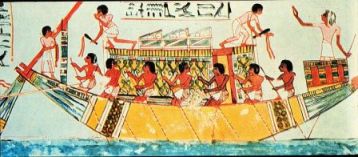
Transportation in ancient Egypt adapted over thousands of years as the civilization developed more sophisticated technologies for movement. Ancient Egyptians mastered diverse environments from the waters of the Nile River and Mediterranean Sea to the harsh climate of the Sahara. The ancient Egyptians used animals, wheeled chariots and ships for transporting people, commodities and troops.
History >> Ancient Egypt
The Egyptians didn't build roads to travel around their empire. They didn't need to. Nature had already built them a superhighway right through the middle of their empire called the Nile River.
Most of the major cities in Ancient Egypt were located along the banks of the Nile River. As a result, the Egyptians used the Nile for transportation and shipping from very early on. They became experts at building boats and navigating the river.

Early Boats
Early Egyptians learned to make small boats out of the papyrus plant. They were easy to construct and worked well for fishing and short trips. Most of the papyrus boats were small and were steered with oars and poles. The typical boat was long and thin and the ends came to a point that stuck out of the water.
Wooden Boats
Eventually the Egyptians began to make boats from wood. They used acacia wood from Egypt and imported cedar wood from Lebanon. They also began to use a giant sail in the middle of the boat so they could catch the wind when heading upstream.
The Egyptians built their wooden boats without nails. Boats were often made from a number of short planks that were hooked together and tied tight with ropes. Steering was accomplished by using a large rudder oar at the back of the ships.
Cargo Ships
The Egyptians learned how to build large and sturdy cargo ships. They sailed these up and down the Nile and into the Mediterranean Sea to trade with other countries. These ships could hold lots of cargo. Some ships were used to carry huge stones weighing as much as 500 tons from the rock quarry to where the pyramids were being constructed.
Funeral Boats
The Egyptians believed that a boat was needed in the afterlife in order to journey to the heavens. Sometimes a small model of a boat was buried with a person. Often times a full size boat was included in the tombs of Pharaohs and other wealthy Egyptians. There were 35 boats of some type in the pharaoh Tutankhamun's tomb.
Rowing or Sailing
It turns out that the Nile had another great advantage for boating. When boats were traveling north, they would be going with the current. When the ships were traveling south, they generally had the wind blowing in their direction and would use a sail. The ships often had oars to gain even more speed when traveling in either direction.
How do we know about the boats of Ancient Egypt?
Very few boats from Ancient Egypt have survived for archeologists to study. However, because of the religious importance of boats, there are many surviving models and pictures of boats. These models and pictures tell archeologists a lot about how the boats were constructed and how they were used.
Fun Facts about Egyptian Boats
Information source:
Accessed 10/06/2020
The Egyptians were masters of trade in the ancient world.
What they traded:
Who they traded with and what they received: